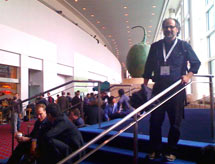
Handy Links
SLAC News Center
SLAC Today
- Subscribe
- Archives: Feb 2006-May 20, 2011
- Archives: May 23, 2011 and later
- Submit Feedback or Story Ideas
- About SLAC Today
SLAC News
Lab News
- Interactions
- Lightsources.org
- ILC NewsLine
- Int'l Science Grid This Week
- Fermilab Today
- Berkeley Lab News
- @brookhaven TODAY
- DOE Pulse
- CERN Courier
- DESY inForm
- US / LHC
SLAC Links
- Emergency
- Safety
- Policy Repository
- Site Entry Form

- Site Maps
- M & O Review
- Computing Status & Calendar
- SLAC Colloquium
- SLACspeak
- SLACspace
- SLAC Logo
- Café Menu
- Flea Market
- Web E-mail
- Marguerite Shuttle
- Discount Commuter Passes
-
Award Reporting Form
- SPIRES
- SciDoc
- Activity Groups
- Library
Stanford
Around the Bay
Taming the Superconductor
Nearly 100 years after the discovery of the superconductor, research into superconductive materials continues at a feverish pace. Over the past 25 years, two new materials have been discovered that allow electricity to flow without resistance at surprisingly high temperatures. These new types of superconductor, called cuprates and pnictides, may become the workhorse superconductors used in everything from solar cells to electronics. If researchers can learn to understand and tame them, that is.
"Understanding how superconductivity arises in these high-temperature superconductors is one of the biggest unsolved problems in condensed matter physics right now," said Tom Devereaux, co-deputy director of the Stanford Institute for Materials and Energy Science, who presented on his recent theoretical research into high-temperature superconductors at the American Physical Society meeting this week in Portland, Oregon.
Conventional superconductors have been understood for decades. In these materials, electrons flow easily, even when that material contains impurities, because the electrons travel in pairs.
"It's as if a bunch of people are trying to move across a football field littered with ditches," Devereaux said. "In the superconductive state, people move in pairs, locking arms and trading partners all the time, so they're locked together." As a result, if a person runs into a ditch, he or she doesn't fall in but is instead carried across by companions, ensuring that all the people—or, in the case of superconductors, all the electrons—make it from one end of the field to the other.
Unfortunately for many commercial applications, conventional superconductors work only at temperatures colder than about 20 kelvin—about -425 degrees Fahrenheit. And while it's possible to maintain that temperature in some applications, it's a significant limiting factor in most.
A breakthrough came in the mid-1980s: experimentalists found that certain chemical compounds containing copper-oxide, called "cuprates," superconduct at temperatures as high as 135 kelvin. In 2006, experimentalists added "pnictides," compounds containing elements from group 15 of the periodic table—such as nitrogen, phosphorus and arsenic—to the list of high-temperature superconductors. At a maximum of -215 and -363 degrees Fahrenheit, respectively, cuprates and pnictides still don't approach room temperature, but they're a very promising step toward this ultimate goal.
The aim now is to understand how these high-temperature superconductors work, but that's proving very challenging. The arrangement of atoms in both cuprates and pnictides must create a system in which electrons interact in a harmonized way, behaving collectively to pull one another across impurities. But how, exactly, do they do this?
"The short answer is we don't know exactly how they work, or even how they differ from one another. A lot of discussions are going on about that now," Devereaux said. "We've found these high-temperature superconductors by serendipity in the past. But if we can understand the most important ingredient that controls the temperature at which a superconductor works, we could build a different type for each application. We could improve power generation and the efficiency of solar cells, and we could build smaller electronics. But first, we need to understand what's going on."
Devereaux said that he expects SIMES researchers to help reveal the secrets of cuprates and pnictides. "SIMES is great because we have people who synthesize samples, others who characterize the samples, and others—like myself—who provide theory. With that and with the ability to use the Stanford Synchrotron Radiation Lightsource and, soon, the Linac Coherent Light Source to characterize materials, we have a unique opportunity to understand high-temperature superconductors."
—Kelen Tuttle
SLAC Today, March 18, 2010
